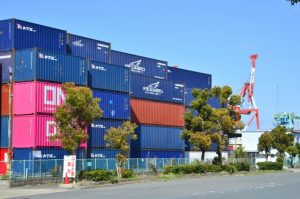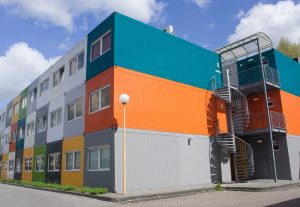The national holidays in China observing the National Day ended on October 12th. During this period, more than 600 million people are said to have moved domestically, which is approx. 80% compared to the previous year. Since overseas travel is restricted by COVID-19, the energy of the people was directed toward domestic travel. By the way, the number of Chinese tourists in 2019 including overseas was 780 million. I feel a huge energy magma of 1.4 billion people. I suppose it will not be long before, when COVID-19 is controlled more effectively, that magma of the people jumps out to all over the world “as inbound”.
With the outbreak of the COVID-19 cluster in the White House, US President Trump, who had been acting strong without a mask, finally was infected with COVID-19 and hospitalized on Oct. 2nd. However, perhaps to show off his toughness or maybe because he couldn’t afford to have a rest with the presidential election close at hand on November 4th, he was discharged from hospital on Oct. 5th.
The World Health Organization (WHO) announced on Oct 5th that 10% of the world’s population, that is 780 million people, have been infected with COVID-19 so far. At present, the cumulative number of people infected in the world is 35 million, but it seems that the above number of people have actually been infected. Some people, especially the young it is said, have no symptoms even if they are affected. We need to continue to be careful about our health.
 Drewry, a British maritime consultancy, pointed out container freight rate. Ocean freight in September set a record high in the past eight years. Freight from Shanghai to Los Angeles exceeded $4,000 per FEU to $4,085 per FEU, 191% up year-on-year. As for freight from Shanghai to New York, it was $4,879 per FEU, 90% up year-on-year. From Shanghai to Rotterdam, it increased 84% year-on-year. It is reported that other routes also exceeded the same period of the previous year.
Drewry, a British maritime consultancy, pointed out container freight rate. Ocean freight in September set a record high in the past eight years. Freight from Shanghai to Los Angeles exceeded $4,000 per FEU to $4,085 per FEU, 191% up year-on-year. As for freight from Shanghai to New York, it was $4,879 per FEU, 90% up year-on-year. From Shanghai to Rotterdam, it increased 84% year-on-year. It is reported that other routes also exceeded the same period of the previous year.
The reasons for this rise in ocean freight are the recovery of production activities in China, the demand for daily commodities in North America and Europe, and seasonal factors for Christmas sales goods. This is also evidenced by National Retail Federation (NRF) statistics. Import record was 1.76 million TEU in June, 1.92 million TEU in July, and it reached 2.06 million TEU in August (6% up year-on-year), a record high on a monthly basis. The peak of exports from China and Asia in summer is September. Due to the reduced cargo movement under COVID-19, the shipping lines reduced the number of vessels for self-defense. This has hindered the empty positioning of containers idling in Europe and the United States to China and Asia, which has spurred the rise in ocean freight.
Meanwhile, China’s Ministry of Transport has requested that the price increase be stopped, and the US Federal Maritime Commission (FMC) has warned shipping lines and alliances in response to this unprecedented increase in freight rates, saying that it will issue an injunction against the raise in ocean freight if it is determined that they have violated the competitive conditions. But isn’t this irrational? What do they think about the current situation in which shipping companies are competing for fierce freight rates to fill the space of container ships? They do not mention the current situation where cargo is loaded at a freight level that is considered to be below cost, and under such circumstances shipping companies cannot avoid withdrawal or bankruptcy. A good example is the bankruptcy of Hanjin Shipping in 2016, who was the 7th largest in the world at that time. The bankruptcy of Hanjin Shipping gave unimaginable turmoil to ships, terminals and container industries. Is it okay to let such unreasonable thing happen? Given that the current freight increase is the result of a balance between supply and demand, they should stay away from intervention in the current freight increase.
The factory inventory of new containers in China at the end of September was 403,282 TEU (Dry: 347,351 TEU, Reefer: 55,931 TEU). The new container price was $2,250 per 20f. The production in September alone was 349,466 TEU (Dry: 316,023 TEU, Reefer: 33,443 TEU), the largest this year. As a result, considering the remaining factory inventory in the previous month, it can be said that 550,676 TEU new build containers were delivered from the factories in China for export in September.
The Suga Cabinet started on September 16th. He participated in the Abe administration, which lasted for seven years and eight months, as Chief Cabinet Secretary. He is not a hereditary councilor. After graduating from high school, he came to Tokyo to get a job and had a hard time graduating from Hosei University. In 1996, he ran for the 41st House of Representatives from Kanagawa 2nd district and was elected for the first time. He is the Chancellor of the common people. He established Minister in charge of Administrative Reform, State of Regulatory Reform in order to change the dull administration and old regulations that was exposed by the COVID-19 measures, and also established Minister for Digital Transformation to improve administrative efficiency. We hope that the government will break down the vertically-divided administration and thoroughly reform the regulations. He also emphasized the diversity and revitalization of companies by expanding the employment of women and foreigners in companies and promoting mid-career recruitment.
It was reported in the Nikkei newspaper on September 23rd that a referendum was held in Italy to reduce one-third of parliamentarians and was passed with about 70% in favor. This will reduce the 630 seats in the House of Representatives to 400, and the Senate from 315 to 200. It is estimated to have an annual cost reduction effect of 100 million euros (about 12 billion yen). Wouldn’t it possible to cut the number of Japanese Diet members in half? Perhaps, IT, AI, and IoT might help to realize it.
 There is one thing I would like to ask Prime Minister Suga in relation to the work I am involved in. Now in Japan, when using ISO containers for stores, houses, and warehouses, building certification is required. In case of ISO container, I would like him to change current system so that building certification is no more necessary. If there is no building certification necessary, the number of opportunities to use ISO containers in Japan will increase tremendously. The economic effect would be immeasurable.
There is one thing I would like to ask Prime Minister Suga in relation to the work I am involved in. Now in Japan, when using ISO containers for stores, houses, and warehouses, building certification is required. In case of ISO container, I would like him to change current system so that building certification is no more necessary. If there is no building certification necessary, the number of opportunities to use ISO containers in Japan will increase tremendously. The economic effect would be immeasurable.
New build ISO containers are manufactured according to ISO standards and are released to the market after passing rigorous inspections so that containers can withstand 7-tier stowage on container ships. An average of 2.5 million TEU of new ISO containers are manufactured each year. Containers are handled by gantry cranes and forklifts in mechanized ports and factories, and transported by container ships and container chassis. Once cargo is delivered at destination, containers are returned to the container depot operated by the shipping lines and leasing companies, where containers will be inspected again and repaired, if necessary, to meet certain criteria. On the other hand, new containers do not require regular inspections for the first 5 years, but after that they do require regular inspections every 2.5 years. However, if you obtain ACEP, they are exempt from the inspection. Do such ISO containers really need a building certification? Only Japan requires a building certification to install ISO containers. We expect that ISO containers should be used more in Japan to cope with disasters. We would like to ask him to seriously consider for innovation.